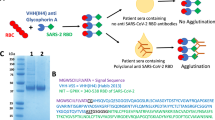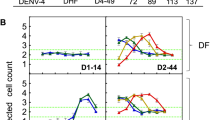Abstract
VISNA is a slow virus disease of sheep characterised by a long subclinical period followed by a slowly progressing clinical illness1. The persistent visna infection is not preceded by an acute clinical phase or by rapid virus replication. This is puzzling because visna virus replicates rapidly in sheep cell cultures2,3. In an attempt to resolve this paradox we inoculated visna virus into sheep cell cultures maintained in fluids with 90% sheep serum but otherwise containing the same nutrients as control cultures maintained without serum. We found that viral growth was much slower in cultures with 90% serum than in control cultures. Further experiments showed that normal sheep sera inactivate visna virus rapidly at 37 °C. We conclude that sheep sera have a visna virus inhibiting factor (VIF) and hypothesise that VIF inhibits early spread of visna virus in inoculated sheep and may be involved in initiating the persistent infection.
This is a preview of subscription content, access via your institution
Access options
Subscribe to this journal
Receive 51 print issues and online access
$199.00 per year
only $3.90 per issue
Buy this article
- Purchase on Springer Link
- Instant access to full article PDF
Prices may be subject to local taxes which are calculated during checkout
Similar content being viewed by others
References
Sigurdsson, B. Br. vet. J. 110, 341–354 (1954).
Thormar, H. Virology 19, 273–278 (1963).
Thormar, H. Slow Virus Diseases of Animals and Man (ed. Kimberlin, R. H.) 97–114 (North Holland, Amsterdam, 1976).
Sigurdsson, B., Thormar, H. & Pálsson, P. A. Archs ges. Virusforsch. 10, 368–381 (1960).
Wiśniewski, H. M. Br. med. Bull. 33, 54–59 (1977).
Gudnadóttir, M. & Pálsson, P. A. J. Immun. 95, 1116–1120 (1966).
Thormar, H. & Pálsson, P. A. Perspectives Virol. 5, 291–308 (1967).
Pétursson, G., Nathanson, N., Georgsson, G., Panitch, H. & Pálsson, P. A. Lab. Invest. 35, 402–412 (1976).
Haase, A. T. & Varmus, H. E. Nature new Biol. 245, 237–239 (1973).
Haase, A. T., Stowring, L., Narayan, O., Griffin, D. E. & Price, D. Science 195, 175–177 (1977).
Haase, A. T. Curr. Topics Microbiol. Immun. 72, 101–156 (1975).
Thormar, H. Curr. Topics Microbiol. Immun. 40, 21–32 (1967).
Thormar, H. & Sigurdardóttir, B. Acta path. microbiol. scand. 55, 180–186 (1962).
Thormar, H. & von Magnus, H. Acta path. microbiol. scand. 57, 261–267 (1963).
Brown, H. R. & Thormar, H. Microbios 13, 51–60 (1975).
Koprowski, H. J. Immun. 54, 387–394 (1946).
Klein, M. Ann. N. Y. Acad. Sci. 70, 362–368 (1958).
Sekine, N. & Yoshino, K. Archs ges. Virusforsch. 45, 89–98 (1974).
Welsh, R. M. Jr, Cooper, N. R., Jensen, F. C. & Oldstone, M. B. A. Nature 257, 612–614 (1975).
Levy, J. A., Ihle, J. N., Oleszko, O. & Barnes, R. B. Proc. natn. Acad. Sci. U.S.A. 72, 5071–5075 (1975).
Fischinger, P. J., Ihle, J. N., Bolognesi, D. P. & Schafer, W. Virology 71, 346–351 (1976).
Leong, J. C., Kane, J. P., Oleszko, O. & Levy, J. A. Proc. natn. Acad. Sci. U.S.A. 74, 276–280 (1977).
Bang, F. B., Foard, M. & Karzon, D. T. Johns Hopkins Hosp. Bull. 87, 130–143 (1950).
Krizanová, O. & Rathová, V. Curr. Topics Microbiol. Immun. 47, 125–151 (1969).
Author information
Authors and Affiliations
Rights and permissions
About this article
Cite this article
THORMAR, H., WISNIEWSKI, H. & LIN, F. Sera and cerebrospinal fluids from normal uninfected sheep contain a visna virus inhibiting factor. Nature 279, 245–246 (1979). https://doi.org/10.1038/279245a0
Received:
Accepted:
Issue Date:
DOI: https://doi.org/10.1038/279245a0
This article is cited by
-
Identification of lipid components of human serum lipoproteins involved in the inhibition of Sindbis virus infectivity, hemagglutination, and hemolysis
Archives of Virology (1988)
-
Pathogenesis of lentivirus infections
Nature (1986)
-
Role of phospholipids in rhabdovirus attachment to CER cells
Archives of Virology (1984)
Comments
By submitting a comment you agree to abide by our Terms and Community Guidelines. If you find something abusive or that does not comply with our terms or guidelines please flag it as inappropriate.



